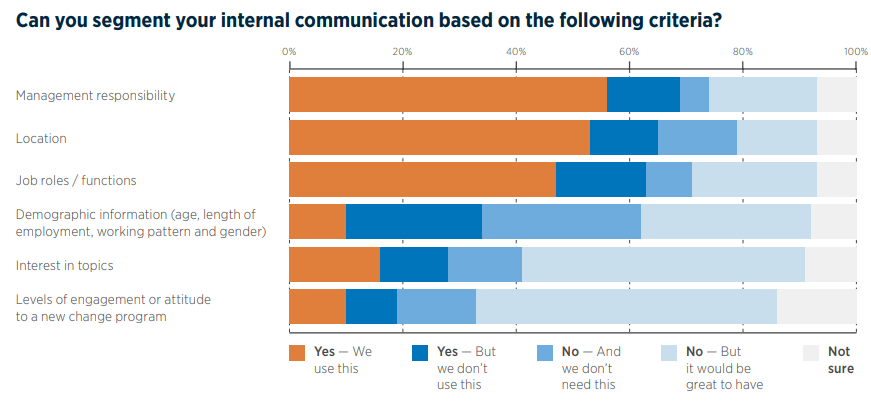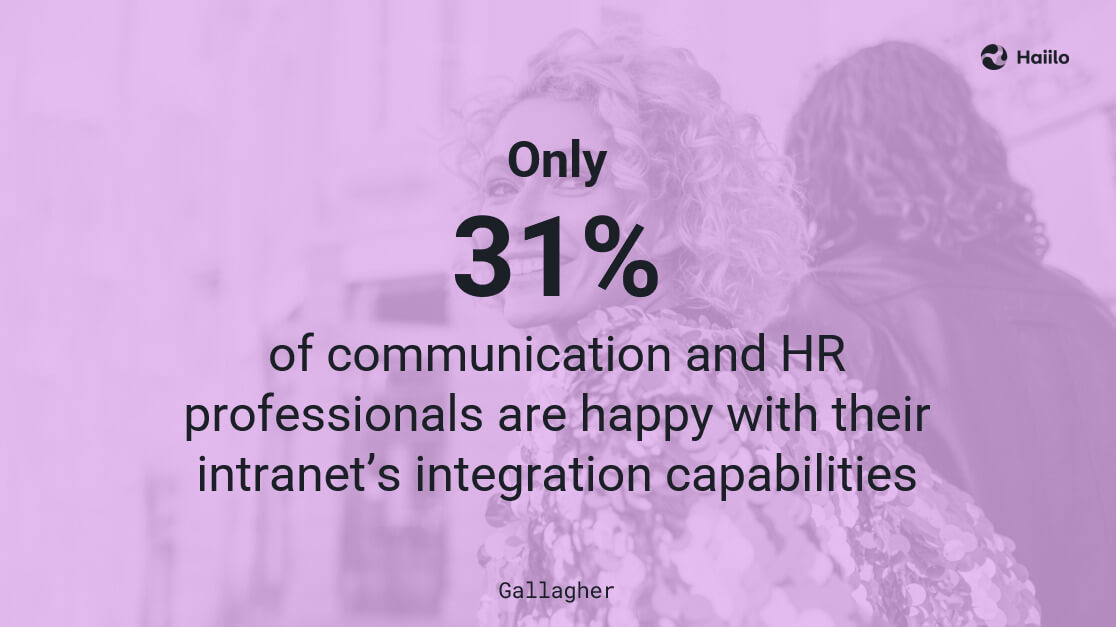Intranet implementation can be demanding. But to get the most out of your intranet platform, it is critical that you follow certain best practices.
Historically, intranets have had a reputation of unintuitive workplace technologies. Today, however, social intranets are social-media-like platforms, and they are a must-have tool in any organization’s tech stack.
According to research by Gallagher, 46% of leaders, communications, and HR professionals think they need to invest more in communication technology. Consequently, the demand for social intranets has skyrocketed with the emergence of remote work, and intranets are now on the top of the list of workplace technologies employers want to implement.

Features such as file sharing, workgroups, communication channels, newsfeeds, and employee directories can go a long way in enabling asynchronous communication, knowledge sharing, and remote collaboration.
Still, Gartner research shows that 90% of intranets fail to meet their initial objectives. The biggest reason for that is low user adoption. Because an intranet is only as successful as the amount of energy and engagement employees put into it.
So in this blog, we will go over some of the best intranet practices that will help you get the most out of this powerful technology, improve user adoption, and boost employee engagement.
💡 Before we move forward, learn about the importance of employee engagement apps in the workplace!
Schedule a personalized demo to see Haiilo social intranet in action
- 1. Choose an Intranet That Meets Your Business Objectives
- 2. Look Beyond Standard Features
- 3. Define Ownership and Content Governance Processes
- 4. Pay Close Attention to User Experience
- 5. Ensure Personalized Employee Experience
- 6. Provide Seamless Access to Information with a Powerful Search Engine
- 7. Use It to Strengthen Your Internal Brand
- 8. Make It Accessible to Every Employee, Anytime
- 9. Integrate with Other Tools to Build a True Digital Workplace
- 10. Encourage Employee Advocacy
- 11. Prioritize Security
- 12. Use the Intranet to Understand Your Employees’ State of Mind
- 13. Measure the Impact of Your Intranet On the Business's Bottom Line
1. Choose an Intranet That Meets Your Business Objectives
To get the most out of your intranet platform, you first need to define the business objectives you are looking to achieve with this internal communication tool. When identifying goals, try to be as specific as possible so that you can measure the impact later on.
Some of the examples of your objectives may include:
- Increase employee engagement by 10%
- Reach all employees across various communication channels
- Improve access and readership of company news and updates by 40%
- Improve strategy comprehension and increase alignment
- Improve employee productivity by reducing information overload
- Improve employee advocacy by 35%
When evaluating different intranet platforms, make sure that you communicate your goals with the vendor. The vendor should be able to present different ways their solution can help you reach desired outcomes.
💡Related: Top 5 Internal Communications Apps: How To Choose the Best One
2. Look Beyond Standard Features
The next intranet best practice includes evaluating different features and functionalities. Most intranet platforms offer similar functionalities around:
- Content studio to make it easy for creators to create and share information across the organization.
- Social collaboration so that employees can connect on a social level, like, comment, and react to the company’s and peers’ posts.
- Search function with which employees can search for files, documents, and other content across multiple apps and locations, making it easy to find the information they need.
- Employee directory allows employees to easily look up their colleagues, learn more about them, and find their contact information.

But if you want to achieve more with your intranet and turn it into a true engagement and productivity tool, you should look for more than just standard features.
Some intranet platforms, for example, offer advanced integration options (more about integrations later in this post). Some providers have built-in pulse surveys and more advanced workplace analytics. Finally, some solutions offer an added-value, such as employee advocacy to enable your employees to become true brand ambassadors.
3. Define Ownership and Content Governance Processes
It is easier to follow certain intranet best practices when you have a designated group of people who manage it. Your intranet team could include roles such as content owners, content creators, technical teams, internal communications professionals, human resources professionals, product owners involved with integrations, and advocates who promote the use of the intranet internally.
Next, you should implement some processes and procedures around content governance which may include:
- Publishing standards
- Branding, page layouts, and templates
- Content revision and approval workflows
In large organizations, these processes can get very complex. So it is critical that content governance is not a manual process. With your intranet platform, you should be able to define role-based permissions on multiple levels and build workflows to make the governance as automated as possible.
4. Pay Close Attention to User Experience
UX and UI can make or break your intranet implementation project. Yet only 38% of communication and HR professionals are happy with their intranet’s design and navigation.

Your intranet should serve as a digital home from which employees will start their day and access the information and tools they need to finish their day. But that doesn’t mean that your intranet should be unintuitive. Oftentimes, the simpler your intranet is, the more likely you will see higher usage rates.
On the other hand, if it is difficult to use the intranet and too hard to find relevant information, the intranet is likely to fail.
Every employee app should be designed around how your employees will actually use it. The most important tools and access links should be placed upfront so that they are easy to navigate.
Your intranet’s homepage shouldn’t be cluttered with irrelevant information because information overload is one of the main causes of poor employee experience in the workplace.
More about content relevancy and personalized employee experience in the next section.
5. Ensure Personalized Employee Experience
Personalized employee experience can make a huge difference when it comes to early adoption and usage of your intranet. The content employees see should be relevant to their roles, locations, divisions, languages, interests, and other criteria.
Unfortunately, around 50% of communication and HR professionals say that their technology doesn’t allow them to serve content based on employees’ interests, and targeting based on the level of engagement is even lower.

Intranet admins should be able to segment audiences and always deliver content relevant to the end user. Only when employees find information relevant will they engage with it and return to the intranet daily.
However, the use of audience segmentation and personalization remains extremely limited, which is often due to technology limitations.
The easiest way to think about this intranet best practice is if you compare the intranet with social media platforms employees use in their private lives. They keep coming back to them because smart algorithms serve them the information they are most likely to like and engage with.
If you want the same effect, make your intranet a social, digital home personalized to every employee!
💡 Related: What is an Employee Experience Platform and Why Your Company Needs One
6. Provide Seamless Access to Information with a Powerful Search Engine
Your organization’s intranet should be a go-to place for employees to find every piece of information they need fast, from any device.
So when evaluating vendors, make sure that you test their product’s search function. Using relevant keywords, employees should be able to easily find files, documents, materials, and conversations across different tools integrated into the intranet platform.
Whether the file they are looking for is located within the intranet, attached to an email, or stored in a shared Google Drive, your employees should be able to find and access it instantly.
📹 Your intranet can go a long way in improving your internal communications strategy. Check out our Masterclass about how to create a successful internal comms strategy!
7. Use It to Strengthen Your Internal Brand
Your intranet should be your employees’ digital home. Ideally, it should be the very first thing people see when they open their internet browser. So besides just improving your employees’ productivity at work, intranet platforms can be very useful in strengthening your company’s employer brand.
To follow this intranet best practice, make sure that the vendor you choose offers white labeling services. This will enable you to match the look and feel of the platform to your company’s branding guidelines and instantly make the new platform look familiar to the employees.
In general, companies that put effort into branding their intranet have higher adoption rates and engagement than those that don’t.
8. Make It Accessible to Every Employee, Anytime
It is important to make your intranet accessible to every employee. For example, your frontline workers without a designated working space or a corporate email should have the same level of access as your office workers. And your remote and hybrid workers should have the same level of access as your on-site workers.
There are two major intranet characteristics that make some intranets more accessible than others:
- Cloud-based solution – make sure the intranet software is easy to access without the need for a corporate device. Cloud-based (SaaS) software enables employees to access it anywhere.
- Mobile app – Mobile intranet access is key to the success of intranet usage and adoption. According to research, 72% of employees access internal digital channels through business-owned mobile devices and 43% access them from personal mobile devices. So if you want to make sure that your Millennials and Gen Zers use your intranet daily, make sure that your provider offers a branded mobile app.
9. Integrate with Other Tools to Build a True Digital Workplace
Integrating your intranet with other tech stack in your organization is critical for making the platform a true productivity booster and eliminating communication barriers in the workplace.
Unfortunately, only 31% of comms and HR professionals are happy with their intranet’s integration capabilities.

To make your intranet a true digital workplace, you need to make it a single-entry point into the wider portfolio of applications your workforce uses daily. Otherwise, your intranet’s adoption rates won’t be as high.
Look for a platform that offers deep integrations with critical solutions such as Google Workspace and Microsoft 365. Additionally, your intranet should integrate with your Active Directory (AD) so that your organizational data can be mapped to and automatically updated in your intranet.
Next, make sure the provider offers integration with the communication channels such as Slack and MS Teams. This way, content can be easily distributed to multiple internal channels to make sure that important information reaches every employee. Additionally, some intranet platforms integrate with social media channels, making the intranet a powerful employee advocacy tool.
Last but not least, make sure that you choose the software that offers API with which you can create custom integrations.
10. Encourage Employee Advocacy
Not many organizations think of employee advocacy when implementing an intranet. But there are vendors who offer advocacy features built into their intranet platforms.
If you decide to go with such a solution, make sure that you encourage employee advocacy, as it can be the most powerful way to boost your brand’s awareness, sales, and talent acquisition efforts.
Social intranets with employee advocacy features make employee brand ambassadorship easy and rewarding. Employees can share their company’s content with their personal networks in seconds, and companies can track and reward those who are most engaged.
11. Prioritize Security
The need for highly secure workplace tools has skyrocketed in the previous couple of years.
At the very minimum, your intranet should offer SSL encryption, single-sign-on (SSO authentication), secure storage, and security certificates such as ISO 27001.
Additionally, make sure that the platform does not link or store personal data to file accesses and that the vendor can make your data available to you as an export at the end of the term.
12. Use the Intranet to Understand Your Employees’ State of Mind
You won’t find this feature in many intranet platforms on the market. But if you are considering implementing a new solution, you may want to look for software that enables you to send regular surveys to your employees.
This is the best way to understand the employee experience factors that drive higher employee engagement, prevent high turnover rates, and improve employee wellbeing as well as improve your internal comms qualitatively.
Ideally, the solution should be very easy to use and give you actionable insights about the vibes of your workforce. It should be integrated with the main communication channels in your workplace (including SMS) so that you can distribute surveys efficiently and increase the response rate.
13. Measure the Impact of Your Intranet On the Business’s Bottom Line
Intranet analytics is one of the biggest pain points in this software category. Only 21% of IC and HR professionals are happy with their intranet’s analytics features and functionalities.

Measuring the impact of your intranet can also help you define best practices that work for your organization. By regularly analyzing intranet data, you should be able to better understand what works and what doesn’t.
Measuring your intranet usage can help you understand what type of content best resonates with your employees and, therefore, improve your internal communications efforts. Furthermore, you should look for insights into which communication channels best work for your audience and adjust your distribution strategy accordingly.
The most advanced solutions also allow you to align your communication campaigns with specific business goals. According to research by Gallagher, 24% of communications and HR professionals’ main goal is to measure the ROI of workplace communications. But 22% said that lack of analytics or measurement was their biggest challenge.
Even though most intranets offer some kind of analytics, not many give you easy-to-read reports and analytics with actionable recommendations for improvement. Instead, you get downloadable reports with raw data and spend hours in excel spreadsheets to make a better sense of numbers.
So make sure that you closely evaluate your next intranet’s reporting and analytics functionalities!










